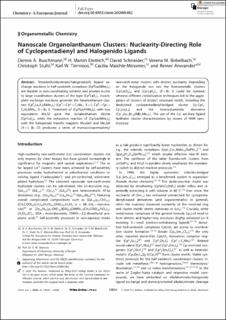Nanoscale organolanthanum clusters: Nuclearity-directing role of cyclopentadienyl and halogenido ligands
Buschmann, Dennis A.; Dietrich, H. Martin; Schneider, David; Birkelbach, Verena M.; Stuhl, Christoph; Törnroos, Karl Wilhelm; Maichle-Mössmer, Cäcilia; Anwander, Reiner
Journal article, Peer reviewed
Published version

Åpne
Permanent lenke
https://hdl.handle.net/11250/2763111Utgivelsesdato
2020Metadata
Vis full innførselSamlinger
- Department of Chemistry [433]
- Registrations from Cristin [9791]
Sammendrag
Tetramethylaluminato/halogenido(X) ligand exchange reactions in half-sandwich complexes [CpRLa(AlMe4)2] are feasible in non-coordinating solvents and provide access to large coordination clusters of the type [CpRLaX2]x. Incomplete exchange reactions generate the hexalanthanum clusters [CpR6La6X8(AlMe4)4] (CpR=Cp*=C5Me5, X=I; CpR=Cp′=C5H4SiMe3, X=Br, I). Treatment of [Cp*La(AlMe4)2] with two equivalents Me3SiI gave the nonalanthanum cluster [Cp*LaI2]9, while the exhaustive reaction of [Cp′La(AlMe4)2] with the halogenido transfer reagents Me3GeX and Me3SiX (X=I, Br, Cl) produced a series of monocyclopentadienyl rare-earth-metal clusters with distinct nuclearity. Depending on the halogenido ion size the homometallic clusters [Cp′LaCl2]10 and [Cp′LaX2]12 (X=Br, I) could be isolated, whereas different crystallization techniques led to the aggregation of clusters of distinct structural motifs, including the desilylated cyclopentadienyl-bridged cluster [(μ-Cp)2Cp′8La8I14] and the heteroaluminato derivative [Cp′10La10Br18(AlBr2Me2)2]. The use of the Cp′ ancillary ligand facilitates cluster characterization by means of NMR spectroscopy.
